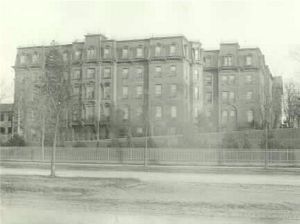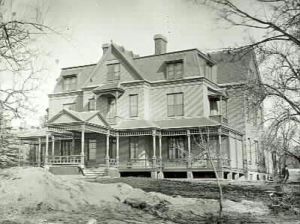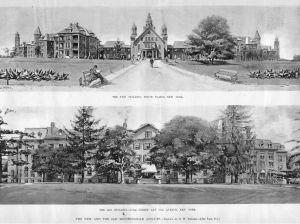This post is written by local historian Jim Mackin based on his presentation for the Bloomingdale Neighborhood History group on November 16, 2015. The topic covers two of our themes: the medical history of the Bloomingdale neighborhood, and another building that (almost) is no longer in existence.
Jim Mackin is a member of the BNHG’s Planning Committee, presenting popular presentations on behalf of the group, as well as leading monthly neighborhood history walking tours.
It all began in 1769. Two students were graduating with medical degrees from King’s College. Twenty-eight-year old Dr. Samuel Bard gave the commencement speech that so moved city leaders that enough funds were pledged to establish a hospital. In 1776, New York Hospital became the 3rd oldest hospital when it opened just in time to treat some rag-tag colonials wounded by shot from British men-of-war ships moving up the Hudson.
Mentally ill patients were treated from the very beginning of the hospital along with all other patients. But the number of mentally ill patients was rising greatly. In 1802 a committee was formed to consider an addition to the building, and any other planning, to accommodate the increase of what were the called “lunatics.” But more radical action was taken by the establishment of a separate and new department in the hospital to accommodate mentally ill patients, and the construction of a separate and new asylum building in 1808. This asylum of 80 beds was the only one of its kind in New York State.
New approaches to treatment of the mentally ill by Dr. Pinel in Paris and William Tuke who established the Retreat for the Insane in York, England. Patients were to be no longer kept in seclusion, let alone in chains. Treatment was becoming understood as “moral” instead of “medical”. The changes had sweeping implications: patients were “visited” and physical activity for patients was encouraged.
A committee consisting of Thomas Eddy, John R Murray, John Aspinwall, Thomas Buckley, Cadwallader Colden, and Peter A Jay decided on a site in Bloomingdale for a new and separate institution for the treatment of the mentally ill. They purchased land from Gerald DePeyster on what is now where Columbia University resides in Morningside Heights. The cornerstone for the Bloomingdale Insane Asylum was laid on May 7th, 1818, and the building was officially opened on June 1st, 1821. This is how it appeared on the early Randel Farm Maps (1818-1820):
The building was made mostly of limestone and was 60 ft. wide and 211 ft. long. That would make it as long as say from 103rd to 104th St. By 1824, there were 120 patients.
In 1829, a building was erected 117 ft. northwest of the main building to house noisy and violent men. The building was made of brick, 57 by 32 ft., 3 stories high, with 33 rooms, and iron bars on the windows. A similar building for noisy and violent female patients was erected in 1837. Here is an image of how the Asylum looked in 1834:
In 1834 when there were 134 patients, 38 acres southeast of the grounds were sold (for $24,755) to the Leake and Watts Orphan Asylum. In 1839, “pauper patients” in the Bloomingdale Asylum were moved to the new Lunatic Asylum that was opened by the City on Blackwell’s Island, today called Roosevelt Island. A Superintendent and a Matron administered the Asylum. The Asylum also had a resident physician from the beginning in 1821. By 1848, and for $75 a year, Croton Water came to the Bloomingdale Insane Asylum.
In 1843, Dorothea Dix visited the Bloomingdale Insane Asylum. In 1851, she visited the BIA again, this time rendering her comments to the Board of Governors. From this, some $52,000 was raised to build two additions to the facilities that separately housed the noisy and violent men and women. They were each two stories high and 100 ft long and housed about 150 patients. In 1862, additional funds expanded the asylum further and connected the buildings into a wing-type design. In response to a point made by Miss Dix about a noisy engine and laundry, a separate 3-story building, 75 ft. by 40 ft., was built for laundry and as a residence for domestics. In 1875, pumping water from wells was ended with a direct connection to the Croton water supply that ran down present Amsterdam Avenue. Also in 1875, a conservatory of brick, wood, and glass, containing a plant house, aviary and aquarium was erected.
On September 16, 1876, as many as 10,000 people were estimated to have congregated to Bloomingdale Heights to celebrate the 100th anniversary of the Battle of Harlem Heights.
In 1880, the BIA site was given consideration, along with another site in Inwood and another site at Port Morris in the Bronx, for the 1883 World’s Fair Exhibition that would celebrate the 100th anniversary of the end of the Revolutionary War (Treaty of Paris). Here is an image of the proposed plan:
In 1880, the $130,000 John C. Green Memorial Building for female patients was opened with a donation from his widow. John C. Green made his fortune in the China trade, and he gave much of it to Princeton University and the Bloomingdale Insane Asylum. The Green building was attached to the main building on the west side. When Columbia University moved to the site in 1897, this building was renovated and used by Columbia as “College Hall.” Here is a photograph of the Green Building whose architect was Ralph Townsend:
Ralph Townsend was also the architect of the Macy Villa that survives to this day.
Columbia University has used the Macy Villa in various capacities with the names of Buell Hall, and Maison Francaise. Trustee and donor, William H. Macy, funded it for use by wealthy male patients. William H. Macy was a cousin to R. H. (Rowland Howland) Macy of department store fame and he made his fortune in oil and becoming part of Rockefeller’s Standard Oil. Here is an early photograph of the Macy Villa:
As early as the 1860s various factors compelled the trustees of New York Hospital to consider moving the Bloomingdale Insane Asylum. In the late 1860s they purchased nearly 300 acres in White Plains and established a farm facility for patients. Some serious though was given to moving New York Hospital from its location on lower Broadway to the Bloomingdale site. In 1889, the Asylum began selling property to finance a complete move to their White Plains property. They sold lots that were between 112th and 114th Streets and between Amsterdam Avenue and Broadway. Here is a map of the Bloomingdale Insane Asylum in 1891:
In 1892, the Asylum sold its land between 116th and 120th Streets to Columbia University. In 1954, President Dwight D. Eisenhower, who had been Columbia’s president (1948-1953), used his influence to have 116th St between Amsterdam and Broadway closed to traffic and bricked over to commemorate CU’s bicentennial.
When the Bloomingdale Insane Asylum moved to White Plains, the street on which it was located then and now was named Bloomingdale Road. Very recently, a Bloomingdale’s department store opened on Bloomingdale Road.
Here is the Bloomingdale Insane Asylum in White Plains (top) and in Morningside Heights (bottom):








Ah, so nice to remember where we put violent and noisy women